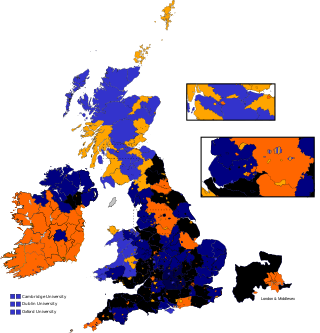Top Qs
Timeline
Chat
Perspective
West Somerset (UK Parliament constituency)
Parliamentary constituency in the United Kingdom, 1832–1885 From Wikipedia, the free encyclopedia
Remove ads
West Somerset or Somerset Western (formally The Western division of Somerset) was the name of a parliamentary constituency in the county of Somerset between 1832 and 1885. It returned two Members of Parliament to the House of Commons of the Parliament of the United Kingdom, elected by the bloc vote system.
Remove ads
Boundaries
Summarize
Perspective
1832–1868
1832–1868: The Hundreds of Abdick and Bulstone, Andersfield, Cannington, Carhampton, Crewkerne, North Curry, Houndsborough, Berwick and Coker, Huntspill and Puriton, Kingsbury East, Kingsbury West, Martock, Milverton, North Petherton, South Petherton, Pitney, Somerton, Stone, Taunton and Taunton Deane, Tintinhull, Whitley, and Williton and Freemanors.[1]
The constituency was created for the 1832 general election, when the former Somerset constituency was divided into new East and West divisions. It also absorbed the voters from the abolished boroughs of Ilchester and Minehead. The constituency might have been better described as South-Western Somerset, since it stretched to the southern as well as the western extremities of the county. It surrounded the county town of Taunton (although Taunton was a borough electing MPs in its own right, freeholders within the borough who met the property-owning qualifications for the county franchise could vote in West Somerset as well, as could those in Bridgwater); otherwise, the largest town was Yeovil, but the division also included Chard, Crewkerne, Minehead, Wellington, Ilminster, Street, Watchet and Wiveliscombe; nevertheless, the majority of voters were in the rural areas.
1868–1885
The Second Reform Act changed the limits greatly for the 1868 general election. It gave the county a third division, Mid Somerset into which were moved the eastern end of this seat (including Yeovil, Street and Crewkerne).
The West gained a new main town, Bridgwater, its seats abolished partly for corruption.
Abolition
The constituency was abolished for the 1885 general election, when those parts of Somerset outside its boroughs were divided into seven single-member county constituencies. West Somerset's voters were divided between the new Bridgwater, South Somerset and Wellington divisions. (The Wellington division, which lasted until 1918, had the alternative name of Western Somerset.)
Remove ads
Members of Parliament
Notes
- Later adopted the surname Vaughan-Lee
Remove ads
Election Results
Summarize
Perspective
Elections in the 1830s
Elections in the 1840s
12321
Elections in the 1850s
Hood's death caused a by-election.
Elections in the 1860s
Moody's resignation caused a by-election.
Elections in the 1870s
Langton's death caused a by-election.
Elections in the 1880s
Lee resigned, causing a by-election.
Bisset resigned, causing a by-election.
Remove ads
References
Wikiwand - on
Seamless Wikipedia browsing. On steroids.
Remove ads

